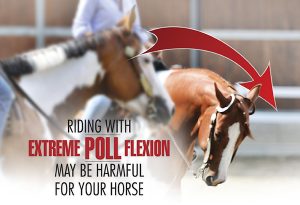Riding With Extreme Poll Flexion May Be Harmful For Your Horse
Click here to read the complete article
438 – September/October, 2023
Extreme flexion, hyper flexion, rollkur or riding low, deep and round–call it what you wish. It’s controversial and a recent study done in Portugal has shown that as little as 15 additional degrees of poll flexion can also affect a horse’s welfare in several significant ways.
Horses are what’s known in the scientific world as obligate nasal breathers. This means that unlike humans, they cannot change to breathing through their mouth if their oxygen needs increase. They can flare their nostrils and dilate the tiny airways that bring oxygen to the air sacs in their lungs but this ability can only do so much to adjust to the increasing need for air during any exercise. Because of this, there are limits to the amount of oxygen a horse can take in and any restriction on the amount of oxygen they are taking in can affect their performance.
Horses also have frictional resistance placed on their airways when they exert themselves as they’re ridden. This creates pressure on the horse’s upper airway which can cause it to collapse.
The way that a horse being asked to work hard prevents this collapse is to extend its head and neck. In many different riding disciplines, but particularly in show jumping and dressage, horses are placed in a posture with their neck and poll tightly flexed and their face behind the vertical. The horse’s head may almost touch its chest or its knees or be turned to one side or the other.
While proponents of this technique say it improves a horse’s ability to lift and round its topline, which is essential for any collected work, while it supples muscles and encourages more expressive gaits. Others, however, contend that it harms the horse and several studies appear to support this conclusion.
Click here to read the complete article
438 – September/October, 2023











